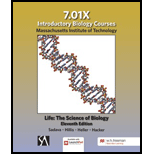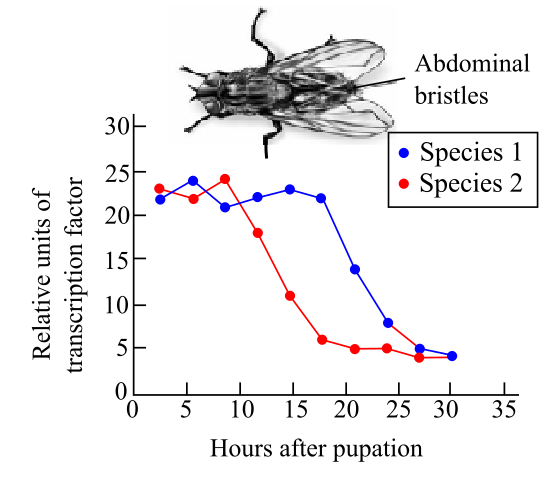
To review:
The results and formulate a hypothesis for the role of a transcription factor in the two species. Also, assess whether it is an example of heterometry, heterotropy, or heterochrony.
Introduction:
Transcription factors are the proteins involved in the process of transcribing the DNA (deoxyribonucleic acid) molecules into RNA (ribonucleic acid). These factors can repress or activate transcription to regulate expression of a gene within a cell of an organism.
Heterometry is referred to the change in the amount of gene expression during the developmental stages of an organism. Heterotropy is termed as the evolutionary change in the spatial pattern of development. Heterochrony is defined as the change in gene expression timings and developmental rates of an organism. The figure shows the gene expression pattern for both species 1 and 2 over the course of time.

Figure: Change in relative units of a transcription factor with time.
Explanation of Solution
It can be clearly observed from the above figure that the two species are relatively different in terms of the duration of time taken for a transcription factor to remain high. In species 1, the duration of gene expression remains longer in comparison to the expression of a transcription factor in species 2. Thus, it is an example of heterochrony due to the differences in their timing of transcription factor’s expression.
Thus, it can be hypothetically stated that the differential timing of expression of the transcription factor causes the morphological difference between species 1 and 2. A longer period of high transcription factor’s expression in species 1 specifically leads to longer abdominal bristles in that species.
Thus, it can be concluded that the species 1 have a longer time of expression of a transcription factor as compared to species 2 and this an example of heterochrony. The morphological differences occur between the two species due to the difference in the timing of expression of the transcription factors.
Want to see more full solutions like this?
Chapter 19 Solutions
LIFE:SCIENCE OF BIOL.(LL) >CUSTOM<
- GENETICS With a schematic diagrams state the differences between dNTP and ddNTParrow_forwardWhich is more problematic for a cell? a. Inversion with break point between genes b. Inversion with break point inside genesarrow_forwardGive only typing answer with explanation and conclusion Briefly describe how DNA is able to be visualized by UV light. Use words like direct absorbance of DNA)arrow_forward
- . Describe FISH analysis is used in findingspecific DNA sequences in a chromosomearrow_forwardGive typing answer with explanation and conclusion Short tandem repeats (STRs) are used for DNA profiling. A STR with _____ (how many) alleles is a better marker to be used for DNA profiling?arrow_forwardIn Biology, why is it bad to have a Keq=1? 2.If Keq=arrow_forward
- Give typing answer with explanation and conclusion The use of which type of endonuclease is more advantageous for genetic cloning: endonucleases generating blunt ends or sticky ends?arrow_forwardSimilarities in ___________ are the basis of similarities in traits. a. karyotype c. the double helix b. DNA sequence d. chromosome numberarrow_forwardCompare and contrast the sizes of different species’ genomes.arrow_forward
- (short answer) Imagine you’ve been offered a deal from a genomics company. You can get a free genome sequence – an analysis of all of your DNA that includes a report of your ancestry, traits and a medical profile. The medical profile tells you about diseases for which you have a low risk of getting, and also those you have a high risk of getting. Are you interested? Why or why not?arrow_forwardDescribe FISH analysis and its application in findingspecific DNA sequences in a chromosome.arrow_forwardShort Answer: What are environmental effects in genes?arrow_forward

 Human Biology (MindTap Course List)BiologyISBN:9781305112100Author:Cecie Starr, Beverly McMillanPublisher:Cengage Learning
Human Biology (MindTap Course List)BiologyISBN:9781305112100Author:Cecie Starr, Beverly McMillanPublisher:Cengage Learning Biology (MindTap Course List)BiologyISBN:9781337392938Author:Eldra Solomon, Charles Martin, Diana W. Martin, Linda R. BergPublisher:Cengage Learning
Biology (MindTap Course List)BiologyISBN:9781337392938Author:Eldra Solomon, Charles Martin, Diana W. Martin, Linda R. BergPublisher:Cengage Learning


